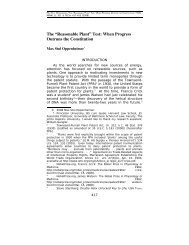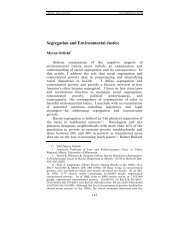An Organizational Approach to the Design of Patent Law
An Organizational Approach to the Design of Patent Law
An Organizational Approach to the Design of Patent Law
You also want an ePaper? Increase the reach of your titles
YUMPU automatically turns print PDFs into web optimized ePapers that Google loves.
6 VERTINSKY FINAL_JAD (DO NOT DELETE) 2/27/2012 2:20 PM<br />
268 MINN. J. L. SCI. & TECH. [Vol. 13:1<br />
remains under-<strong>the</strong>orized. 240 The organizational approach can<br />
provide a broader understanding <strong>of</strong> how international patent<br />
law operates and how international rules might intersect with<br />
domestic rules. Applying <strong>the</strong> approach suggests that international<br />
patent policy should include a broader role for international<br />
norm building; it should be informed by broad principles<br />
<strong>of</strong> compliance that are sensitive <strong>to</strong> local norms and legal system<br />
capacity. The approach supports recent proposals for organizational<br />
innovation in <strong>the</strong> form <strong>of</strong> administrative solutions <strong>to</strong><br />
some <strong>of</strong> <strong>the</strong> challenges <strong>of</strong> international patent lawmaking and<br />
enforcement, as discussed below. 241<br />
The traditional starting point for thinking about international<br />
patent law is <strong>the</strong> Agreement on Trade Related Aspects <strong>of</strong><br />
Intellectual Property (TRIPS), which provides <strong>the</strong> dominant<br />
formal legal framework for international patent law. 242 TRIPS<br />
is housed within <strong>the</strong> World Trade Organization (WTO), a rulesbased<br />
international environment which has <strong>the</strong> stated objective<br />
<strong>of</strong> promoting international trade. 243 TRIPS provides minimum<br />
levels <strong>of</strong> protection that each member state needs <strong>to</strong> provide <strong>to</strong><br />
<strong>the</strong> intellectual property <strong>of</strong> o<strong>the</strong>r members. It also includes certain<br />
broad principles, including national treatment, mostfavored<br />
nation treatment, and <strong>the</strong> principle that intellectual<br />
240. However, important contributions have been made. See generally<br />
Margaret Chon, Substantive Equality in International Intellectual Property<br />
Norm-Setting, in INTELLECTUAL PROPERTY, TRADE AND DEVELOPMENT (Daniel<br />
Gervais ed., 2007); Graeme Dinwoodie & Rochelle Dreyfuss, <strong>Design</strong>ing a Global<br />
Intellectual Property System Responsive <strong>to</strong> Change: The WTO, WIPO and<br />
Beyond, 46 HOUS. L. REV. 1187 (2009); Graeme B. Dinwoodie & Rochelle C.<br />
Dreyfuss, TRIPS and <strong>the</strong> Dynamics <strong>of</strong> Intellectual Property <strong>Law</strong>making, 36<br />
CASE W. RES. J. INT’L L. 95 (2004); Rochelle Dreyfuss, Fostering Dynamic Innovation,<br />
Development and Trade: Intellectual Property as a Case Study in<br />
Global Administrative <strong>Law</strong> (Inst. Int’l L. & Just., Working Paper No. 08-66,<br />
2008), available at http://papers.ssrn.com/sol3/papers.cfm?abstract_<br />
id=1316925 (<strong>to</strong> access article, select One-Click Download); Strandburg, supra<br />
note 44.<br />
241. See Merges, supra note 216; see also Eisenberg, supra note 35.<br />
242. Agreement on Trade-Related Aspects <strong>of</strong> Intellectual Property Rights,<br />
Apr. 15, 1994, 33 I.L.M. 1197 [hereinafter TRIPS Agreement] (establishing a<br />
multilateral agreement creating minimum protection standards for various<br />
forms <strong>of</strong> intellectual property among Member States).<br />
243. See Managing <strong>the</strong> Challenges <strong>of</strong> WTO Participation: 45 Case Studies,<br />
WORLD TRADE ORG., http://www.w<strong>to</strong>.org/english/res_e/booksp_e/casestudies<br />
_e/casestudies_e.htm (last visited Aug. 16, 2010) (“[T]he WTO creates a<br />
framework within which sovereign decision-making can unleash important<br />
opportunities or undermine <strong>the</strong> potential benefits flowing from a rules-based<br />
international environment that promotes open trade.”).






